Research Report: Employee Motivation and Organizational Performance
VerifiedAdded on 2023/01/10
|26
|5487
|28
Report
AI Summary
This research report investigates the impact of servant motivation on organizational performance, focusing on the American Heart Association as a case study. The report explores various motivational factors, including compensation, promotion, and employee recognition, and their influence on employee morale and overall organizational performance. It begins with an introduction highlighting the importance of employee motivation in achieving competitive advantage and addresses the research problem of low employee motivation and its negative impact on organizational growth. The literature review examines motivation concepts and relevant theories, such as the Two-Factor Theory and Maslow's Hierarchy of Needs. The methodology section outlines the research design, population, sample size, and data collection methods. The findings and analysis section presents the influence of compensation, promotion, and recognition on employee morale and performance, supported by tables and data analysis. The report concludes with recommendations and a conclusion summarizing the key findings and their implications for the American Heart Association. The report also includes a conceptual framework and a list of references to support the research.
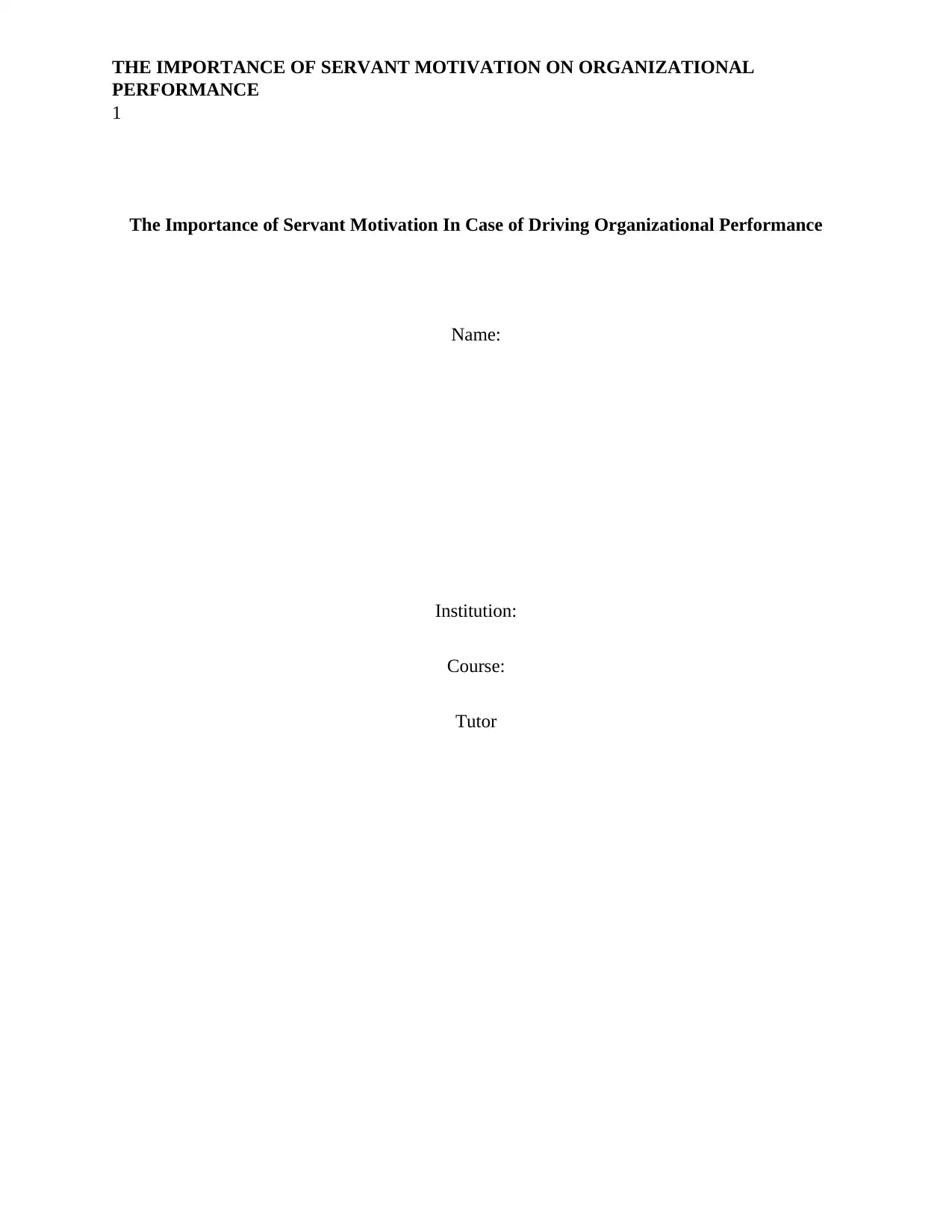
THE IMPORTANCE OF SERVANT MOTIVATION ON ORGANIZATIONAL
PERFORMANCE
1
The Importance of Servant Motivation In Case of Driving Organizational Performance
Name:
Institution:
Course:
Tutor
PERFORMANCE
1
The Importance of Servant Motivation In Case of Driving Organizational Performance
Name:
Institution:
Course:
Tutor
Paraphrase This Document
Need a fresh take? Get an instant paraphrase of this document with our AI Paraphraser
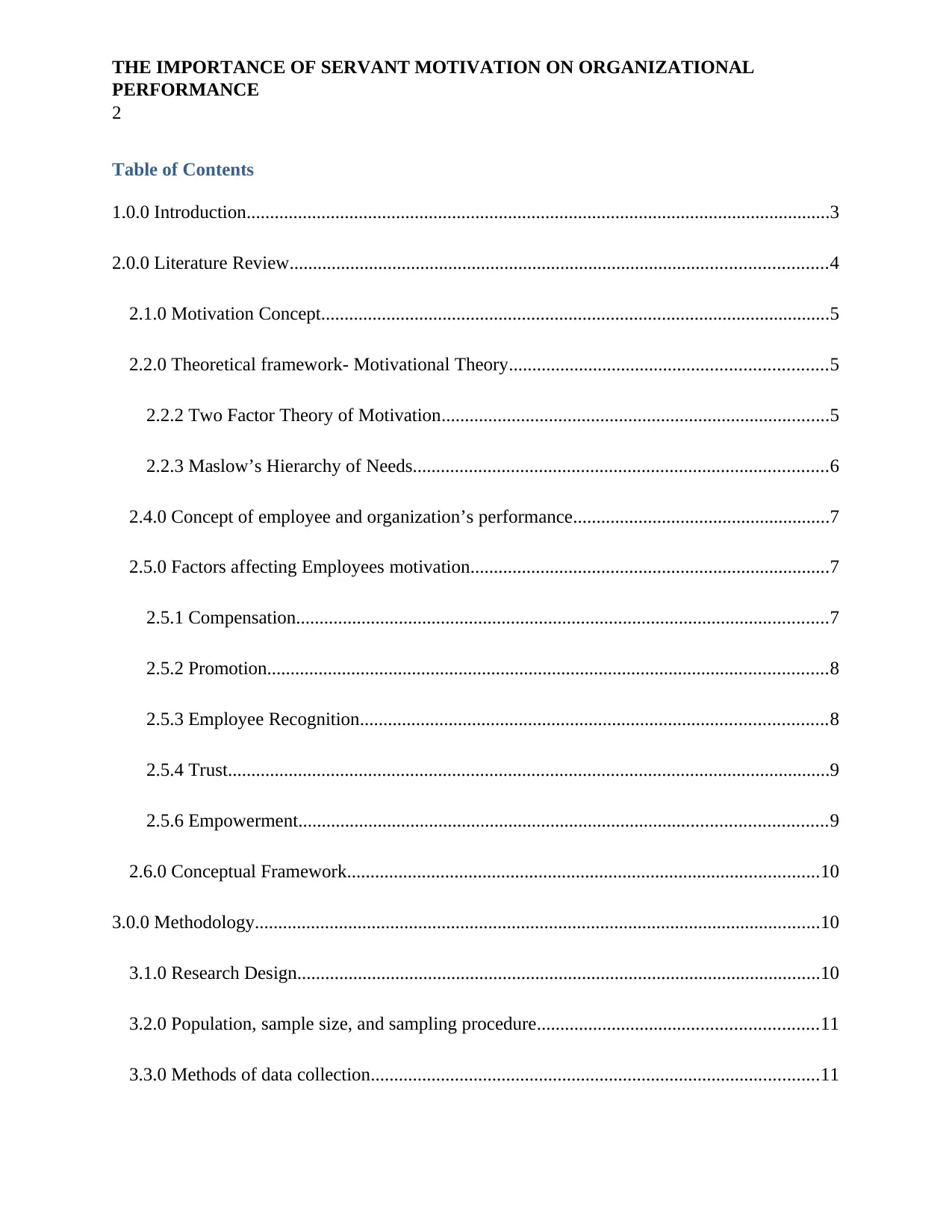
THE IMPORTANCE OF SERVANT MOTIVATION ON ORGANIZATIONAL
PERFORMANCE
2
Table of Contents
1.0.0 Introduction.............................................................................................................................3
2.0.0 Literature Review...................................................................................................................4
2.1.0 Motivation Concept.............................................................................................................5
2.2.0 Theoretical framework- Motivational Theory....................................................................5
2.2.2 Two Factor Theory of Motivation...................................................................................5
2.2.3 Maslow’s Hierarchy of Needs.........................................................................................6
2.4.0 Concept of employee and organization’s performance.......................................................7
2.5.0 Factors affecting Employees motivation.............................................................................7
2.5.1 Compensation..................................................................................................................7
2.5.2 Promotion........................................................................................................................8
2.5.3 Employee Recognition....................................................................................................8
2.5.4 Trust.................................................................................................................................9
2.5.6 Empowerment.................................................................................................................9
2.6.0 Conceptual Framework.....................................................................................................10
3.0.0 Methodology.........................................................................................................................10
3.1.0 Research Design................................................................................................................10
3.2.0 Population, sample size, and sampling procedure............................................................11
3.3.0 Methods of data collection................................................................................................11
PERFORMANCE
2
Table of Contents
1.0.0 Introduction.............................................................................................................................3
2.0.0 Literature Review...................................................................................................................4
2.1.0 Motivation Concept.............................................................................................................5
2.2.0 Theoretical framework- Motivational Theory....................................................................5
2.2.2 Two Factor Theory of Motivation...................................................................................5
2.2.3 Maslow’s Hierarchy of Needs.........................................................................................6
2.4.0 Concept of employee and organization’s performance.......................................................7
2.5.0 Factors affecting Employees motivation.............................................................................7
2.5.1 Compensation..................................................................................................................7
2.5.2 Promotion........................................................................................................................8
2.5.3 Employee Recognition....................................................................................................8
2.5.4 Trust.................................................................................................................................9
2.5.6 Empowerment.................................................................................................................9
2.6.0 Conceptual Framework.....................................................................................................10
3.0.0 Methodology.........................................................................................................................10
3.1.0 Research Design................................................................................................................10
3.2.0 Population, sample size, and sampling procedure............................................................11
3.3.0 Methods of data collection................................................................................................11
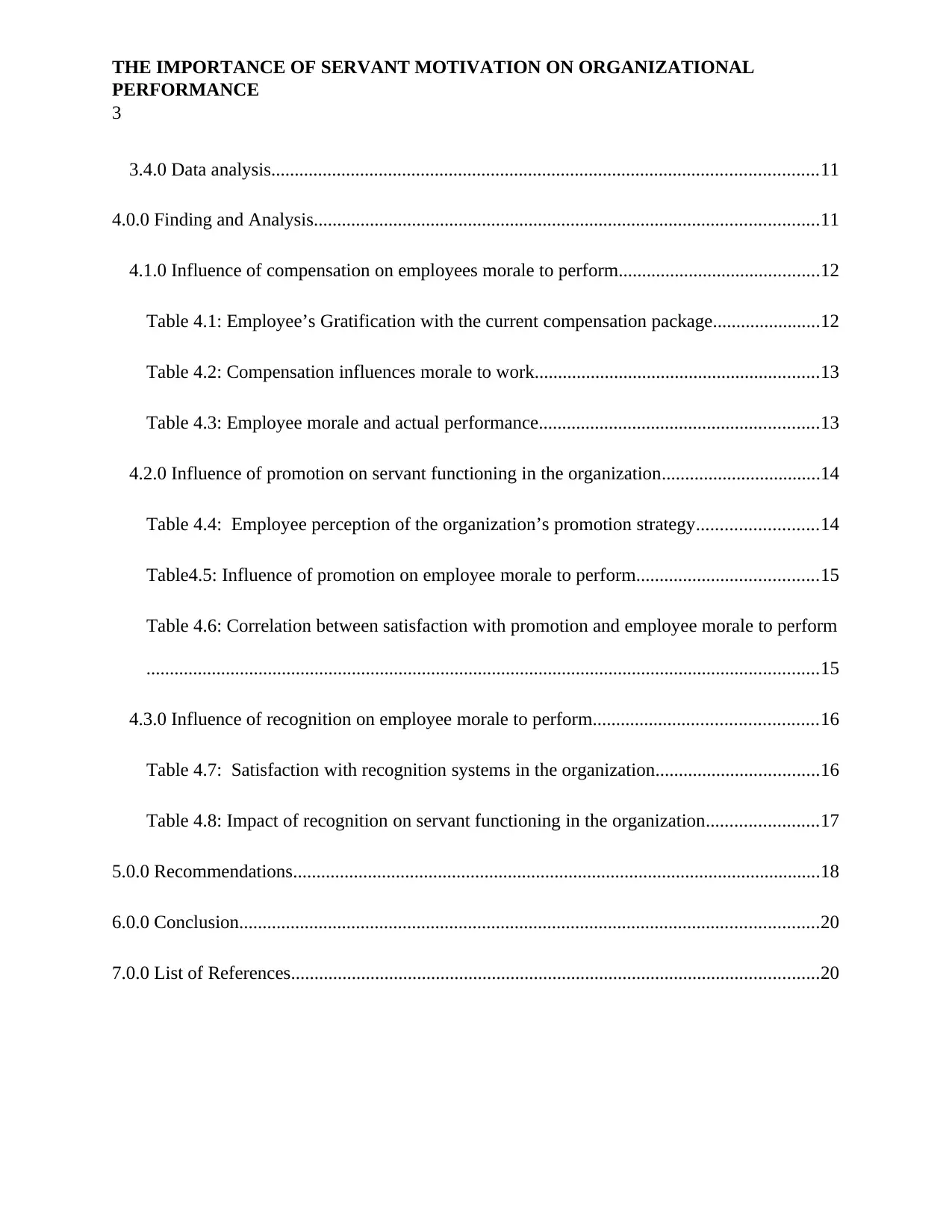
THE IMPORTANCE OF SERVANT MOTIVATION ON ORGANIZATIONAL
PERFORMANCE
3
3.4.0 Data analysis.....................................................................................................................11
4.0.0 Finding and Analysis............................................................................................................11
4.1.0 Influence of compensation on employees morale to perform...........................................12
Table 4.1: Employee’s Gratification with the current compensation package.......................12
Table 4.2: Compensation influences morale to work.............................................................13
Table 4.3: Employee morale and actual performance............................................................13
4.2.0 Influence of promotion on servant functioning in the organization..................................14
Table 4.4: Employee perception of the organization’s promotion strategy..........................14
Table4.5: Influence of promotion on employee morale to perform.......................................15
Table 4.6: Correlation between satisfaction with promotion and employee morale to perform
................................................................................................................................................15
4.3.0 Influence of recognition on employee morale to perform................................................16
Table 4.7: Satisfaction with recognition systems in the organization...................................16
Table 4.8: Impact of recognition on servant functioning in the organization........................17
5.0.0 Recommendations.................................................................................................................18
6.0.0 Conclusion............................................................................................................................20
7.0.0 List of References.................................................................................................................20
PERFORMANCE
3
3.4.0 Data analysis.....................................................................................................................11
4.0.0 Finding and Analysis............................................................................................................11
4.1.0 Influence of compensation on employees morale to perform...........................................12
Table 4.1: Employee’s Gratification with the current compensation package.......................12
Table 4.2: Compensation influences morale to work.............................................................13
Table 4.3: Employee morale and actual performance............................................................13
4.2.0 Influence of promotion on servant functioning in the organization..................................14
Table 4.4: Employee perception of the organization’s promotion strategy..........................14
Table4.5: Influence of promotion on employee morale to perform.......................................15
Table 4.6: Correlation between satisfaction with promotion and employee morale to perform
................................................................................................................................................15
4.3.0 Influence of recognition on employee morale to perform................................................16
Table 4.7: Satisfaction with recognition systems in the organization...................................16
Table 4.8: Impact of recognition on servant functioning in the organization........................17
5.0.0 Recommendations.................................................................................................................18
6.0.0 Conclusion............................................................................................................................20
7.0.0 List of References.................................................................................................................20
⊘ This is a preview!⊘
Do you want full access?
Subscribe today to unlock all pages.

Trusted by 1+ million students worldwide
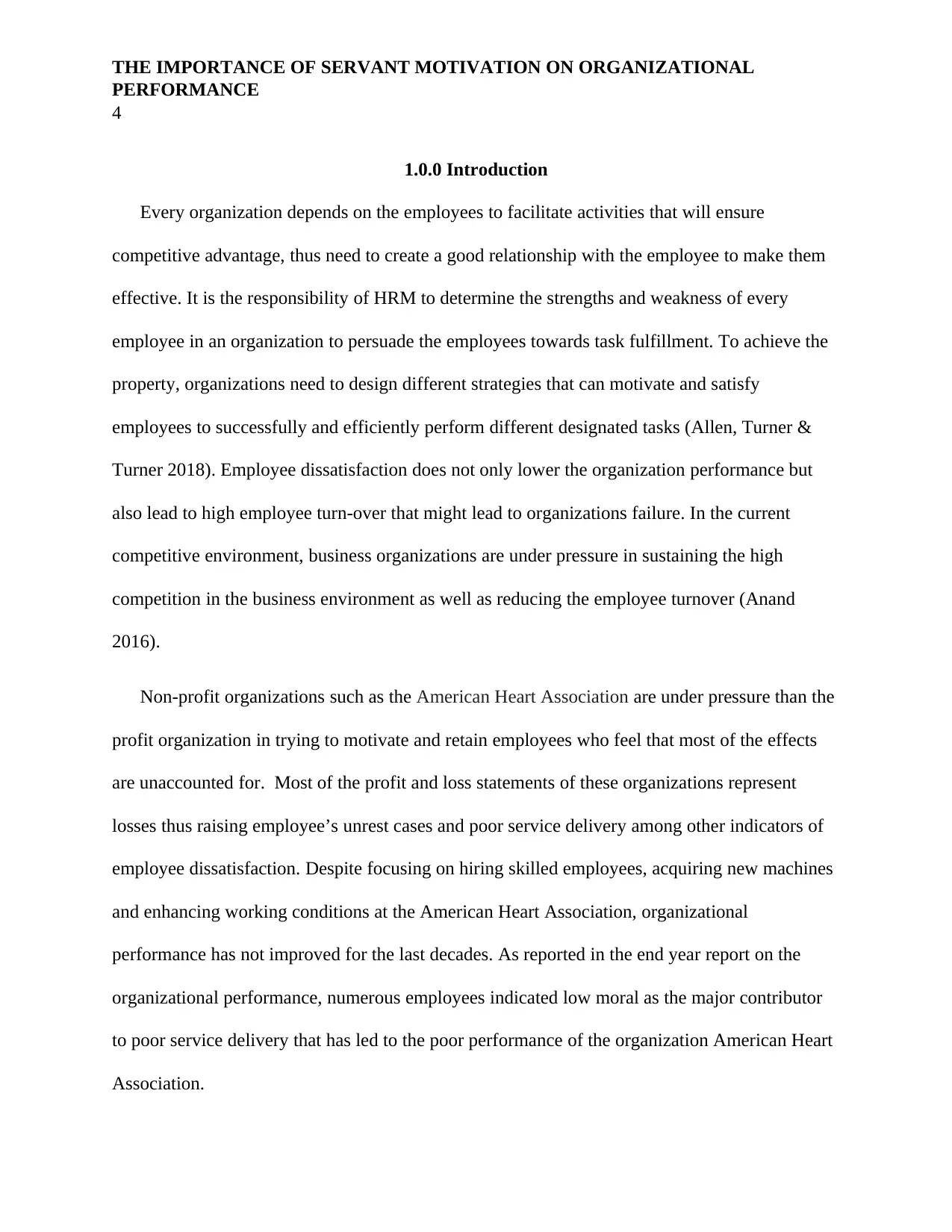
THE IMPORTANCE OF SERVANT MOTIVATION ON ORGANIZATIONAL
PERFORMANCE
4
1.0.0 Introduction
Every organization depends on the employees to facilitate activities that will ensure
competitive advantage, thus need to create a good relationship with the employee to make them
effective. It is the responsibility of HRM to determine the strengths and weakness of every
employee in an organization to persuade the employees towards task fulfillment. To achieve the
property, organizations need to design different strategies that can motivate and satisfy
employees to successfully and efficiently perform different designated tasks (Allen, Turner &
Turner 2018). Employee dissatisfaction does not only lower the organization performance but
also lead to high employee turn-over that might lead to organizations failure. In the current
competitive environment, business organizations are under pressure in sustaining the high
competition in the business environment as well as reducing the employee turnover (Anand
2016).
Non-profit organizations such as the American Heart Association are under pressure than the
profit organization in trying to motivate and retain employees who feel that most of the effects
are unaccounted for. Most of the profit and loss statements of these organizations represent
losses thus raising employee’s unrest cases and poor service delivery among other indicators of
employee dissatisfaction. Despite focusing on hiring skilled employees, acquiring new machines
and enhancing working conditions at the American Heart Association, organizational
performance has not improved for the last decades. As reported in the end year report on the
organizational performance, numerous employees indicated low moral as the major contributor
to poor service delivery that has led to the poor performance of the organization American Heart
Association.
PERFORMANCE
4
1.0.0 Introduction
Every organization depends on the employees to facilitate activities that will ensure
competitive advantage, thus need to create a good relationship with the employee to make them
effective. It is the responsibility of HRM to determine the strengths and weakness of every
employee in an organization to persuade the employees towards task fulfillment. To achieve the
property, organizations need to design different strategies that can motivate and satisfy
employees to successfully and efficiently perform different designated tasks (Allen, Turner &
Turner 2018). Employee dissatisfaction does not only lower the organization performance but
also lead to high employee turn-over that might lead to organizations failure. In the current
competitive environment, business organizations are under pressure in sustaining the high
competition in the business environment as well as reducing the employee turnover (Anand
2016).
Non-profit organizations such as the American Heart Association are under pressure than the
profit organization in trying to motivate and retain employees who feel that most of the effects
are unaccounted for. Most of the profit and loss statements of these organizations represent
losses thus raising employee’s unrest cases and poor service delivery among other indicators of
employee dissatisfaction. Despite focusing on hiring skilled employees, acquiring new machines
and enhancing working conditions at the American Heart Association, organizational
performance has not improved for the last decades. As reported in the end year report on the
organizational performance, numerous employees indicated low moral as the major contributor
to poor service delivery that has led to the poor performance of the organization American Heart
Association.
Paraphrase This Document
Need a fresh take? Get an instant paraphrase of this document with our AI Paraphraser
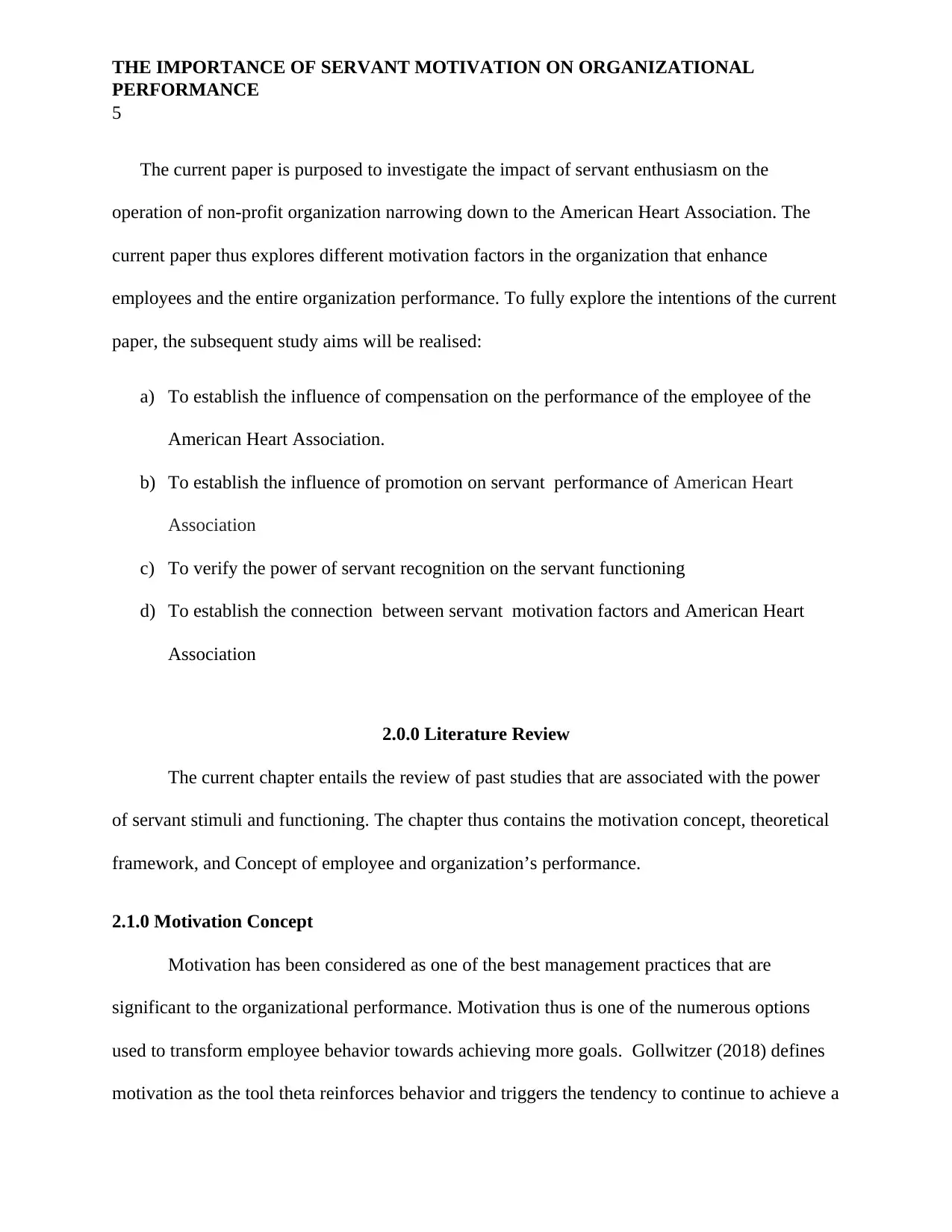
THE IMPORTANCE OF SERVANT MOTIVATION ON ORGANIZATIONAL
PERFORMANCE
5
The current paper is purposed to investigate the impact of servant enthusiasm on the
operation of non-profit organization narrowing down to the American Heart Association. The
current paper thus explores different motivation factors in the organization that enhance
employees and the entire organization performance. To fully explore the intentions of the current
paper, the subsequent study aims will be realised:
a) To establish the influence of compensation on the performance of the employee of the
American Heart Association.
b) To establish the influence of promotion on servant performance of American Heart
Association
c) To verify the power of servant recognition on the servant functioning
d) To establish the connection between servant motivation factors and American Heart
Association
2.0.0 Literature Review
The current chapter entails the review of past studies that are associated with the power
of servant stimuli and functioning. The chapter thus contains the motivation concept, theoretical
framework, and Concept of employee and organization’s performance.
2.1.0 Motivation Concept
Motivation has been considered as one of the best management practices that are
significant to the organizational performance. Motivation thus is one of the numerous options
used to transform employee behavior towards achieving more goals. Gollwitzer (2018) defines
motivation as the tool theta reinforces behavior and triggers the tendency to continue to achieve a
PERFORMANCE
5
The current paper is purposed to investigate the impact of servant enthusiasm on the
operation of non-profit organization narrowing down to the American Heart Association. The
current paper thus explores different motivation factors in the organization that enhance
employees and the entire organization performance. To fully explore the intentions of the current
paper, the subsequent study aims will be realised:
a) To establish the influence of compensation on the performance of the employee of the
American Heart Association.
b) To establish the influence of promotion on servant performance of American Heart
Association
c) To verify the power of servant recognition on the servant functioning
d) To establish the connection between servant motivation factors and American Heart
Association
2.0.0 Literature Review
The current chapter entails the review of past studies that are associated with the power
of servant stimuli and functioning. The chapter thus contains the motivation concept, theoretical
framework, and Concept of employee and organization’s performance.
2.1.0 Motivation Concept
Motivation has been considered as one of the best management practices that are
significant to the organizational performance. Motivation thus is one of the numerous options
used to transform employee behavior towards achieving more goals. Gollwitzer (2018) defines
motivation as the tool theta reinforces behavior and triggers the tendency to continue to achieve a
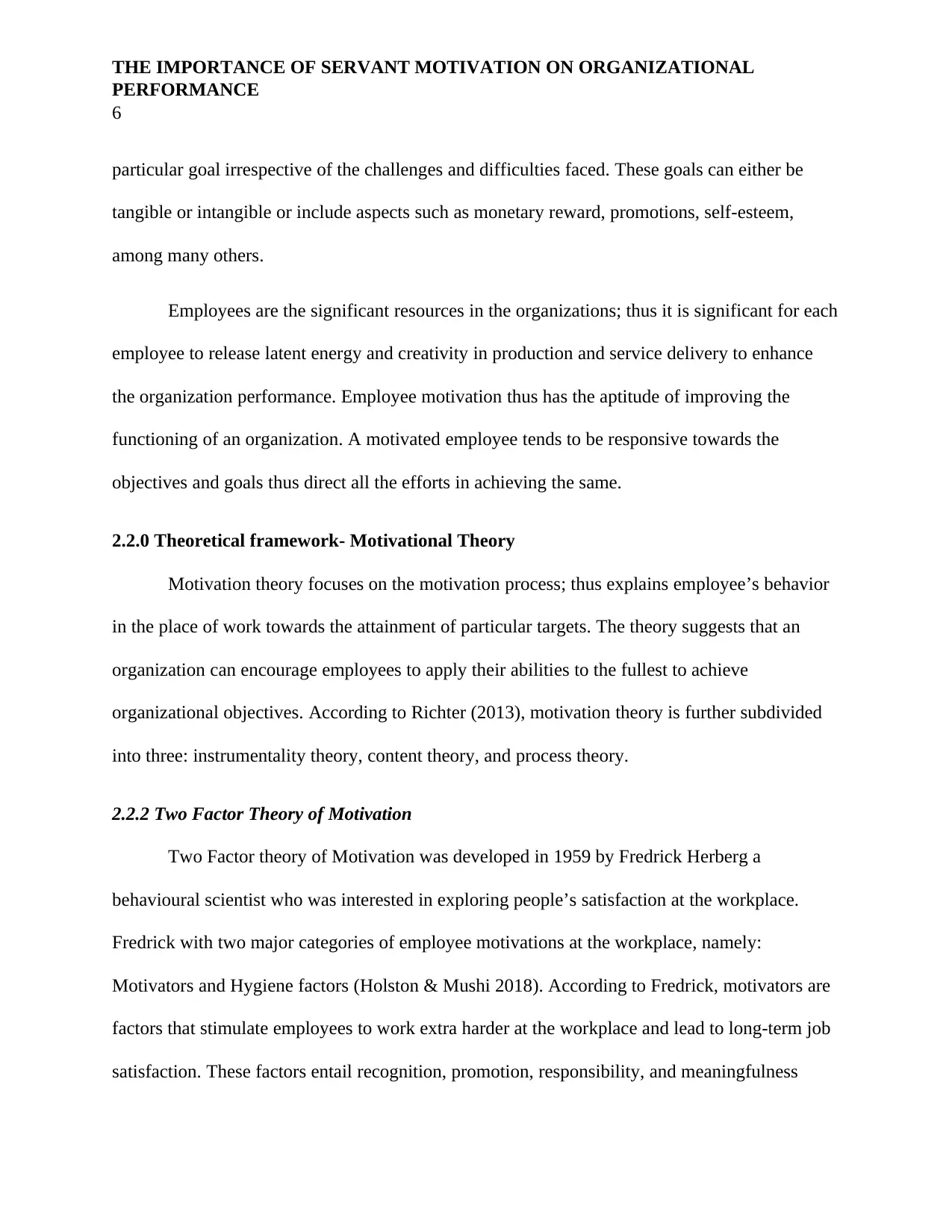
THE IMPORTANCE OF SERVANT MOTIVATION ON ORGANIZATIONAL
PERFORMANCE
6
particular goal irrespective of the challenges and difficulties faced. These goals can either be
tangible or intangible or include aspects such as monetary reward, promotions, self-esteem,
among many others.
Employees are the significant resources in the organizations; thus it is significant for each
employee to release latent energy and creativity in production and service delivery to enhance
the organization performance. Employee motivation thus has the aptitude of improving the
functioning of an organization. A motivated employee tends to be responsive towards the
objectives and goals thus direct all the efforts in achieving the same.
2.2.0 Theoretical framework- Motivational Theory
Motivation theory focuses on the motivation process; thus explains employee’s behavior
in the place of work towards the attainment of particular targets. The theory suggests that an
organization can encourage employees to apply their abilities to the fullest to achieve
organizational objectives. According to Richter (2013), motivation theory is further subdivided
into three: instrumentality theory, content theory, and process theory.
2.2.2 Two Factor Theory of Motivation
Two Factor theory of Motivation was developed in 1959 by Fredrick Herberg a
behavioural scientist who was interested in exploring people’s satisfaction at the workplace.
Fredrick with two major categories of employee motivations at the workplace, namely:
Motivators and Hygiene factors (Holston & Mushi 2018). According to Fredrick, motivators are
factors that stimulate employees to work extra harder at the workplace and lead to long-term job
satisfaction. These factors entail recognition, promotion, responsibility, and meaningfulness
PERFORMANCE
6
particular goal irrespective of the challenges and difficulties faced. These goals can either be
tangible or intangible or include aspects such as monetary reward, promotions, self-esteem,
among many others.
Employees are the significant resources in the organizations; thus it is significant for each
employee to release latent energy and creativity in production and service delivery to enhance
the organization performance. Employee motivation thus has the aptitude of improving the
functioning of an organization. A motivated employee tends to be responsive towards the
objectives and goals thus direct all the efforts in achieving the same.
2.2.0 Theoretical framework- Motivational Theory
Motivation theory focuses on the motivation process; thus explains employee’s behavior
in the place of work towards the attainment of particular targets. The theory suggests that an
organization can encourage employees to apply their abilities to the fullest to achieve
organizational objectives. According to Richter (2013), motivation theory is further subdivided
into three: instrumentality theory, content theory, and process theory.
2.2.2 Two Factor Theory of Motivation
Two Factor theory of Motivation was developed in 1959 by Fredrick Herberg a
behavioural scientist who was interested in exploring people’s satisfaction at the workplace.
Fredrick with two major categories of employee motivations at the workplace, namely:
Motivators and Hygiene factors (Holston & Mushi 2018). According to Fredrick, motivators are
factors that stimulate employees to work extra harder at the workplace and lead to long-term job
satisfaction. These factors entail recognition, promotion, responsibility, and meaningfulness
⊘ This is a preview!⊘
Do you want full access?
Subscribe today to unlock all pages.

Trusted by 1+ million students worldwide
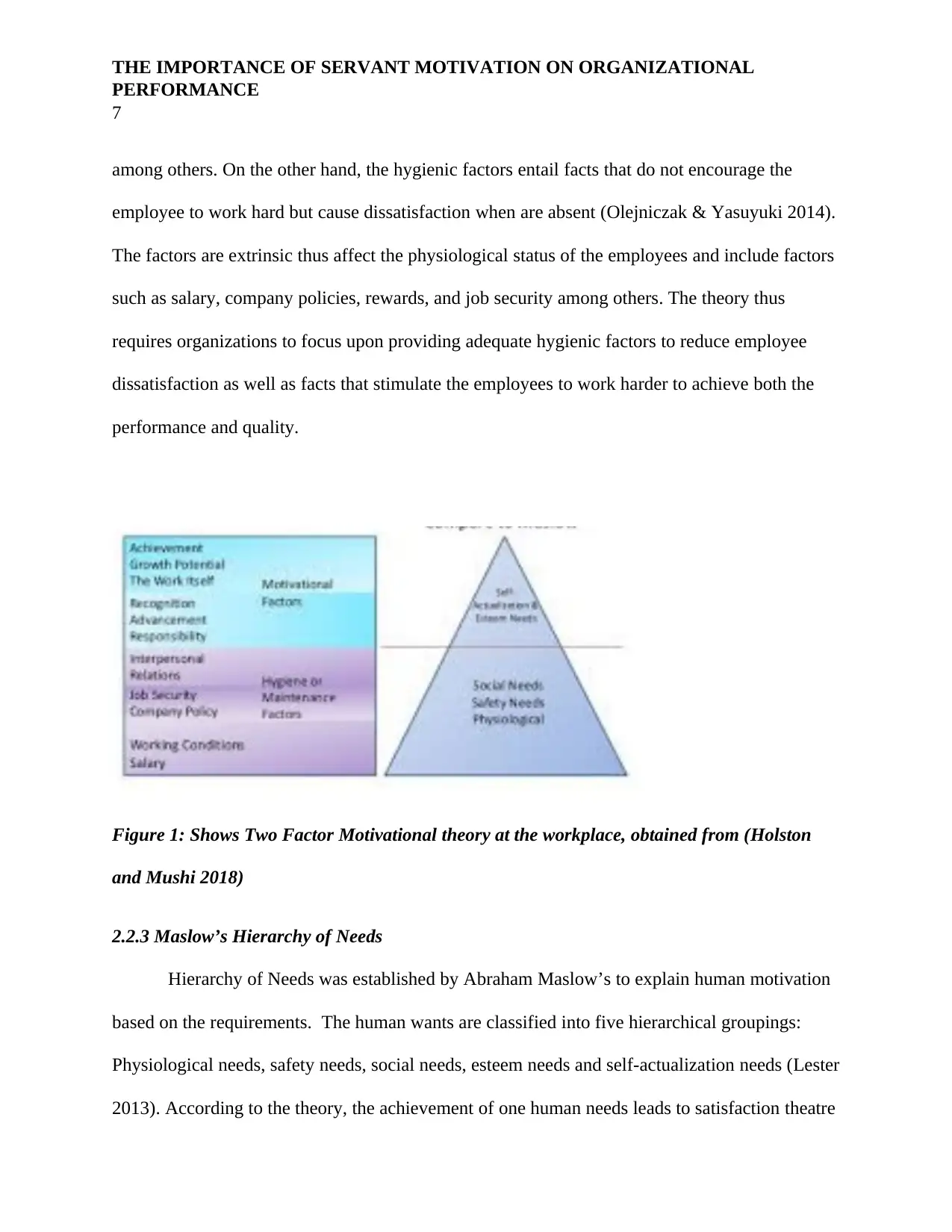
THE IMPORTANCE OF SERVANT MOTIVATION ON ORGANIZATIONAL
PERFORMANCE
7
among others. On the other hand, the hygienic factors entail facts that do not encourage the
employee to work hard but cause dissatisfaction when are absent (Olejniczak & Yasuyuki 2014).
The factors are extrinsic thus affect the physiological status of the employees and include factors
such as salary, company policies, rewards, and job security among others. The theory thus
requires organizations to focus upon providing adequate hygienic factors to reduce employee
dissatisfaction as well as facts that stimulate the employees to work harder to achieve both the
performance and quality.
Figure 1: Shows Two Factor Motivational theory at the workplace, obtained from (Holston
and Mushi 2018)
2.2.3 Maslow’s Hierarchy of Needs
Hierarchy of Needs was established by Abraham Maslow’s to explain human motivation
based on the requirements. The human wants are classified into five hierarchical groupings:
Physiological needs, safety needs, social needs, esteem needs and self-actualization needs (Lester
2013). According to the theory, the achievement of one human needs leads to satisfaction theatre
PERFORMANCE
7
among others. On the other hand, the hygienic factors entail facts that do not encourage the
employee to work hard but cause dissatisfaction when are absent (Olejniczak & Yasuyuki 2014).
The factors are extrinsic thus affect the physiological status of the employees and include factors
such as salary, company policies, rewards, and job security among others. The theory thus
requires organizations to focus upon providing adequate hygienic factors to reduce employee
dissatisfaction as well as facts that stimulate the employees to work harder to achieve both the
performance and quality.
Figure 1: Shows Two Factor Motivational theory at the workplace, obtained from (Holston
and Mushi 2018)
2.2.3 Maslow’s Hierarchy of Needs
Hierarchy of Needs was established by Abraham Maslow’s to explain human motivation
based on the requirements. The human wants are classified into five hierarchical groupings:
Physiological needs, safety needs, social needs, esteem needs and self-actualization needs (Lester
2013). According to the theory, the achievement of one human needs leads to satisfaction theatre
Paraphrase This Document
Need a fresh take? Get an instant paraphrase of this document with our AI Paraphraser
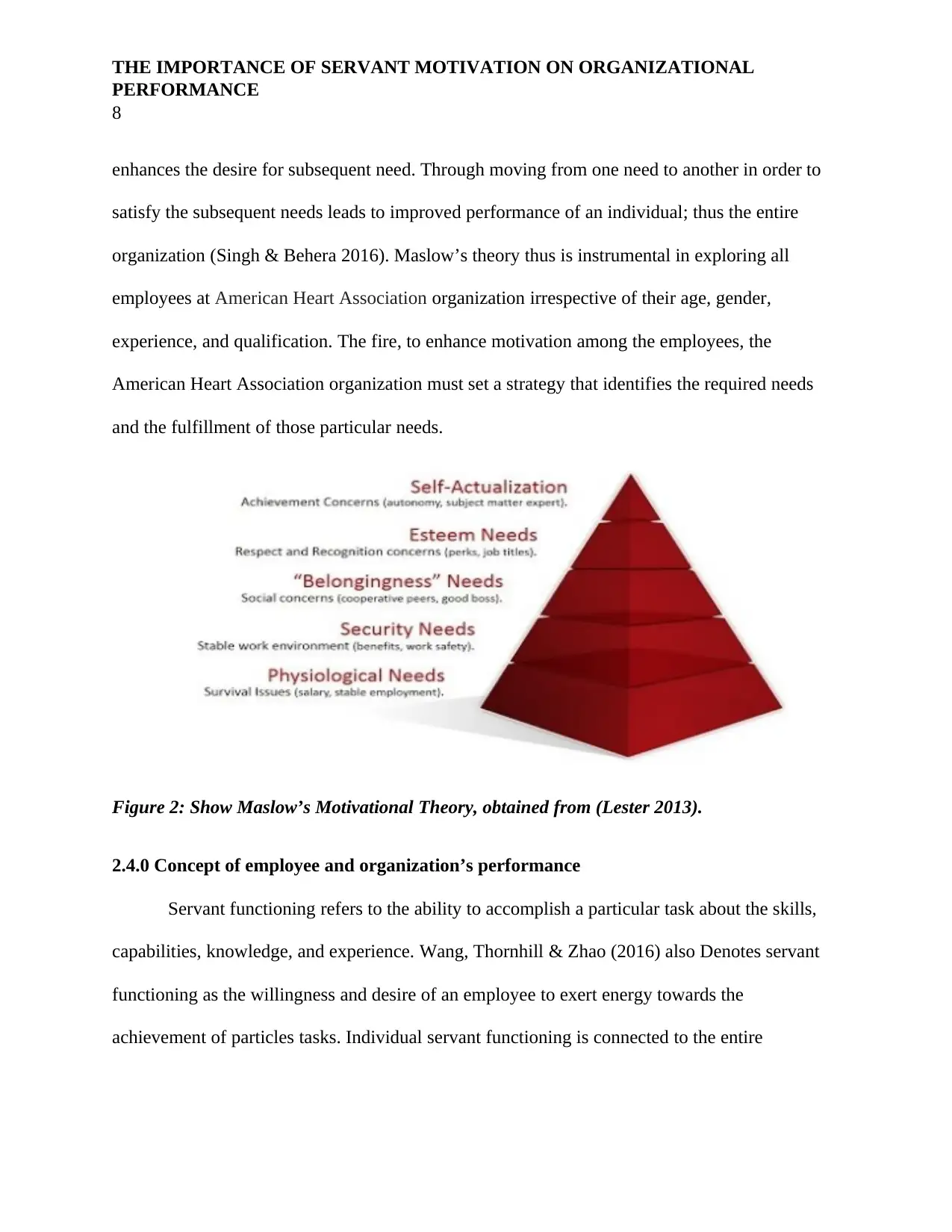
THE IMPORTANCE OF SERVANT MOTIVATION ON ORGANIZATIONAL
PERFORMANCE
8
enhances the desire for subsequent need. Through moving from one need to another in order to
satisfy the subsequent needs leads to improved performance of an individual; thus the entire
organization (Singh & Behera 2016). Maslow’s theory thus is instrumental in exploring all
employees at American Heart Association organization irrespective of their age, gender,
experience, and qualification. The fire, to enhance motivation among the employees, the
American Heart Association organization must set a strategy that identifies the required needs
and the fulfillment of those particular needs.
Figure 2: Show Maslow’s Motivational Theory, obtained from (Lester 2013).
2.4.0 Concept of employee and organization’s performance
Servant functioning refers to the ability to accomplish a particular task about the skills,
capabilities, knowledge, and experience. Wang, Thornhill & Zhao (2016) also Denotes servant
functioning as the willingness and desire of an employee to exert energy towards the
achievement of particles tasks. Individual servant functioning is connected to the entire
PERFORMANCE
8
enhances the desire for subsequent need. Through moving from one need to another in order to
satisfy the subsequent needs leads to improved performance of an individual; thus the entire
organization (Singh & Behera 2016). Maslow’s theory thus is instrumental in exploring all
employees at American Heart Association organization irrespective of their age, gender,
experience, and qualification. The fire, to enhance motivation among the employees, the
American Heart Association organization must set a strategy that identifies the required needs
and the fulfillment of those particular needs.
Figure 2: Show Maslow’s Motivational Theory, obtained from (Lester 2013).
2.4.0 Concept of employee and organization’s performance
Servant functioning refers to the ability to accomplish a particular task about the skills,
capabilities, knowledge, and experience. Wang, Thornhill & Zhao (2016) also Denotes servant
functioning as the willingness and desire of an employee to exert energy towards the
achievement of particles tasks. Individual servant functioning is connected to the entire
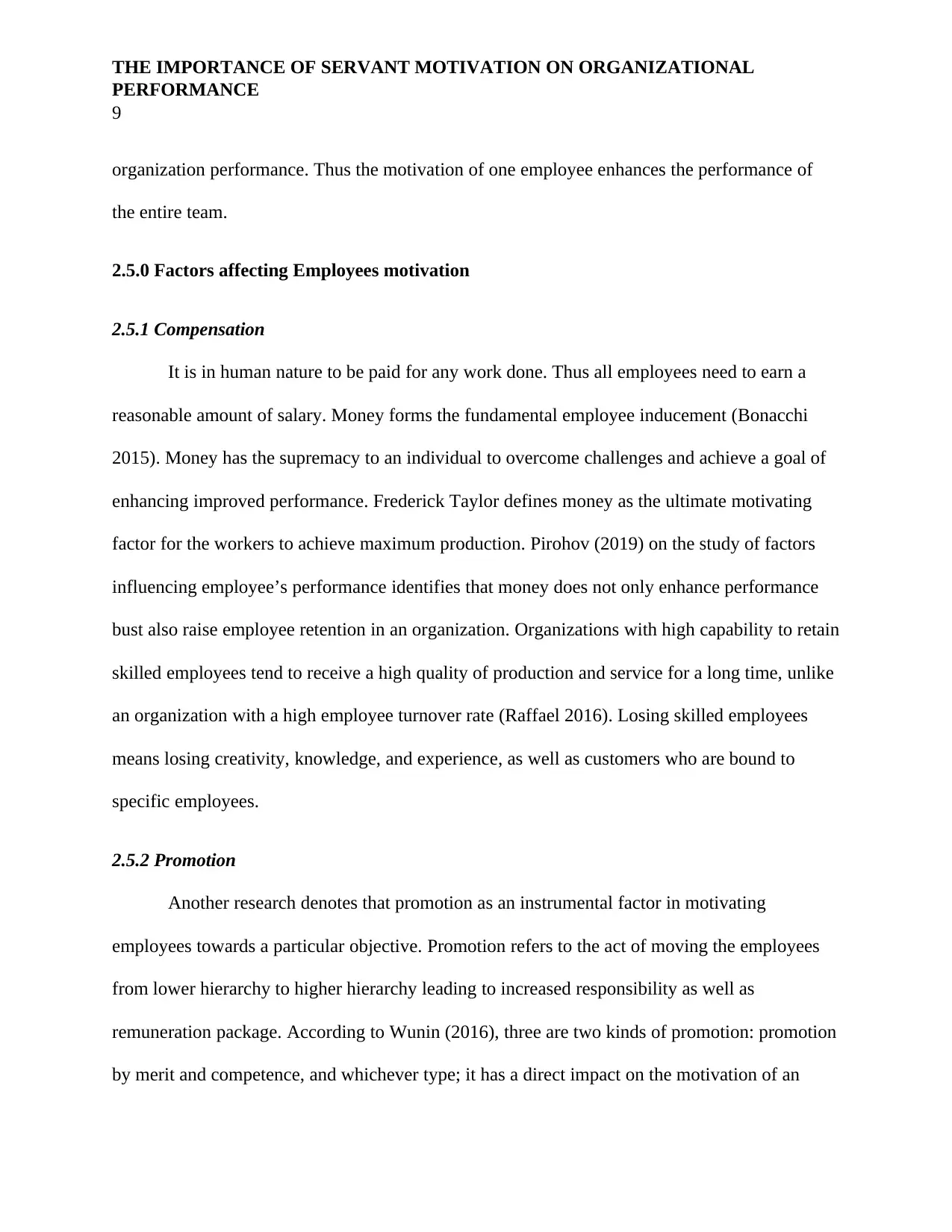
THE IMPORTANCE OF SERVANT MOTIVATION ON ORGANIZATIONAL
PERFORMANCE
9
organization performance. Thus the motivation of one employee enhances the performance of
the entire team.
2.5.0 Factors affecting Employees motivation
2.5.1 Compensation
It is in human nature to be paid for any work done. Thus all employees need to earn a
reasonable amount of salary. Money forms the fundamental employee inducement (Bonacchi
2015). Money has the supremacy to an individual to overcome challenges and achieve a goal of
enhancing improved performance. Frederick Taylor defines money as the ultimate motivating
factor for the workers to achieve maximum production. Pirohov (2019) on the study of factors
influencing employee’s performance identifies that money does not only enhance performance
bust also raise employee retention in an organization. Organizations with high capability to retain
skilled employees tend to receive a high quality of production and service for a long time, unlike
an organization with a high employee turnover rate (Raffael 2016). Losing skilled employees
means losing creativity, knowledge, and experience, as well as customers who are bound to
specific employees.
2.5.2 Promotion
Another research denotes that promotion as an instrumental factor in motivating
employees towards a particular objective. Promotion refers to the act of moving the employees
from lower hierarchy to higher hierarchy leading to increased responsibility as well as
remuneration package. According to Wunin (2016), three are two kinds of promotion: promotion
by merit and competence, and whichever type; it has a direct impact on the motivation of an
PERFORMANCE
9
organization performance. Thus the motivation of one employee enhances the performance of
the entire team.
2.5.0 Factors affecting Employees motivation
2.5.1 Compensation
It is in human nature to be paid for any work done. Thus all employees need to earn a
reasonable amount of salary. Money forms the fundamental employee inducement (Bonacchi
2015). Money has the supremacy to an individual to overcome challenges and achieve a goal of
enhancing improved performance. Frederick Taylor defines money as the ultimate motivating
factor for the workers to achieve maximum production. Pirohov (2019) on the study of factors
influencing employee’s performance identifies that money does not only enhance performance
bust also raise employee retention in an organization. Organizations with high capability to retain
skilled employees tend to receive a high quality of production and service for a long time, unlike
an organization with a high employee turnover rate (Raffael 2016). Losing skilled employees
means losing creativity, knowledge, and experience, as well as customers who are bound to
specific employees.
2.5.2 Promotion
Another research denotes that promotion as an instrumental factor in motivating
employees towards a particular objective. Promotion refers to the act of moving the employees
from lower hierarchy to higher hierarchy leading to increased responsibility as well as
remuneration package. According to Wunin (2016), three are two kinds of promotion: promotion
by merit and competence, and whichever type; it has a direct impact on the motivation of an
⊘ This is a preview!⊘
Do you want full access?
Subscribe today to unlock all pages.

Trusted by 1+ million students worldwide
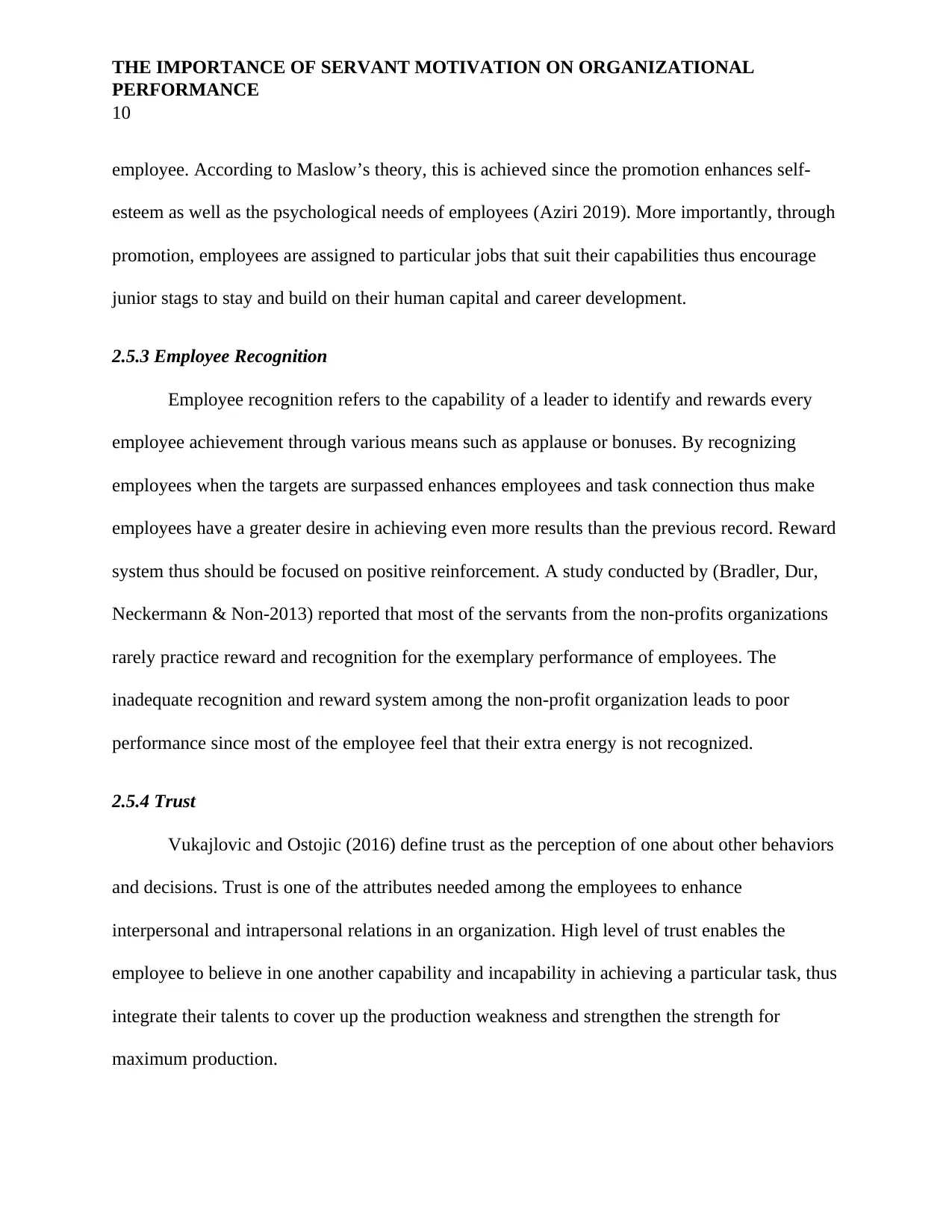
THE IMPORTANCE OF SERVANT MOTIVATION ON ORGANIZATIONAL
PERFORMANCE
10
employee. According to Maslow’s theory, this is achieved since the promotion enhances self-
esteem as well as the psychological needs of employees (Aziri 2019). More importantly, through
promotion, employees are assigned to particular jobs that suit their capabilities thus encourage
junior stags to stay and build on their human capital and career development.
2.5.3 Employee Recognition
Employee recognition refers to the capability of a leader to identify and rewards every
employee achievement through various means such as applause or bonuses. By recognizing
employees when the targets are surpassed enhances employees and task connection thus make
employees have a greater desire in achieving even more results than the previous record. Reward
system thus should be focused on positive reinforcement. A study conducted by (Bradler, Dur,
Neckermann & Non-2013) reported that most of the servants from the non-profits organizations
rarely practice reward and recognition for the exemplary performance of employees. The
inadequate recognition and reward system among the non-profit organization leads to poor
performance since most of the employee feel that their extra energy is not recognized.
2.5.4 Trust
Vukajlovic and Ostojic (2016) define trust as the perception of one about other behaviors
and decisions. Trust is one of the attributes needed among the employees to enhance
interpersonal and intrapersonal relations in an organization. High level of trust enables the
employee to believe in one another capability and incapability in achieving a particular task, thus
integrate their talents to cover up the production weakness and strengthen the strength for
maximum production.
PERFORMANCE
10
employee. According to Maslow’s theory, this is achieved since the promotion enhances self-
esteem as well as the psychological needs of employees (Aziri 2019). More importantly, through
promotion, employees are assigned to particular jobs that suit their capabilities thus encourage
junior stags to stay and build on their human capital and career development.
2.5.3 Employee Recognition
Employee recognition refers to the capability of a leader to identify and rewards every
employee achievement through various means such as applause or bonuses. By recognizing
employees when the targets are surpassed enhances employees and task connection thus make
employees have a greater desire in achieving even more results than the previous record. Reward
system thus should be focused on positive reinforcement. A study conducted by (Bradler, Dur,
Neckermann & Non-2013) reported that most of the servants from the non-profits organizations
rarely practice reward and recognition for the exemplary performance of employees. The
inadequate recognition and reward system among the non-profit organization leads to poor
performance since most of the employee feel that their extra energy is not recognized.
2.5.4 Trust
Vukajlovic and Ostojic (2016) define trust as the perception of one about other behaviors
and decisions. Trust is one of the attributes needed among the employees to enhance
interpersonal and intrapersonal relations in an organization. High level of trust enables the
employee to believe in one another capability and incapability in achieving a particular task, thus
integrate their talents to cover up the production weakness and strengthen the strength for
maximum production.
Paraphrase This Document
Need a fresh take? Get an instant paraphrase of this document with our AI Paraphraser
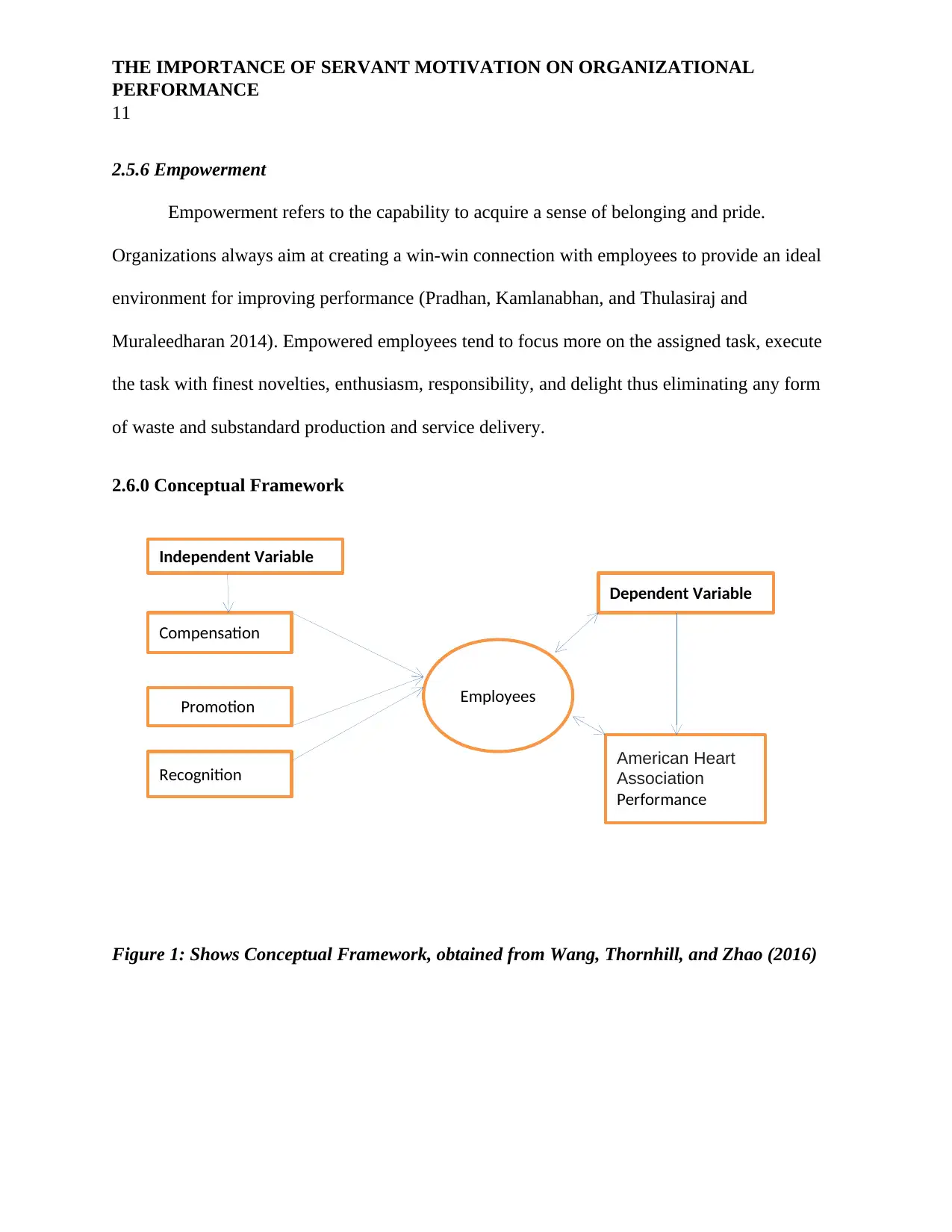
Promotion
Recognition
Compensation
Independent Variable
American Heart
Association
Performance
Dependent Variable
Employees
THE IMPORTANCE OF SERVANT MOTIVATION ON ORGANIZATIONAL
PERFORMANCE
11
2.5.6 Empowerment
Empowerment refers to the capability to acquire a sense of belonging and pride.
Organizations always aim at creating a win-win connection with employees to provide an ideal
environment for improving performance (Pradhan, Kamlanabhan, and Thulasiraj and
Muraleedharan 2014). Empowered employees tend to focus more on the assigned task, execute
the task with finest novelties, enthusiasm, responsibility, and delight thus eliminating any form
of waste and substandard production and service delivery.
2.6.0 Conceptual Framework
Figure 1: Shows Conceptual Framework, obtained from Wang, Thornhill, and Zhao (2016)
Recognition
Compensation
Independent Variable
American Heart
Association
Performance
Dependent Variable
Employees
THE IMPORTANCE OF SERVANT MOTIVATION ON ORGANIZATIONAL
PERFORMANCE
11
2.5.6 Empowerment
Empowerment refers to the capability to acquire a sense of belonging and pride.
Organizations always aim at creating a win-win connection with employees to provide an ideal
environment for improving performance (Pradhan, Kamlanabhan, and Thulasiraj and
Muraleedharan 2014). Empowered employees tend to focus more on the assigned task, execute
the task with finest novelties, enthusiasm, responsibility, and delight thus eliminating any form
of waste and substandard production and service delivery.
2.6.0 Conceptual Framework
Figure 1: Shows Conceptual Framework, obtained from Wang, Thornhill, and Zhao (2016)
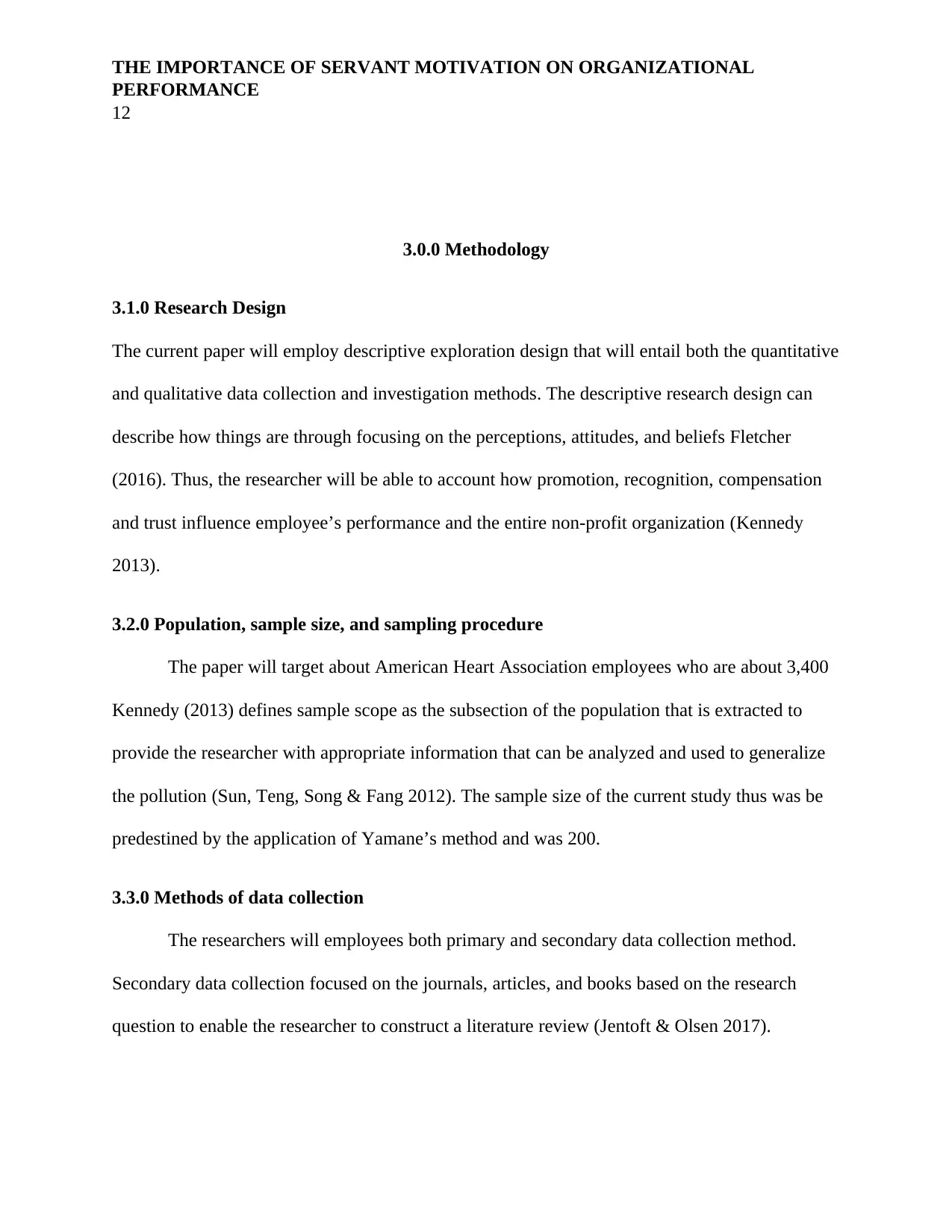
THE IMPORTANCE OF SERVANT MOTIVATION ON ORGANIZATIONAL
PERFORMANCE
12
3.0.0 Methodology
3.1.0 Research Design
The current paper will employ descriptive exploration design that will entail both the quantitative
and qualitative data collection and investigation methods. The descriptive research design can
describe how things are through focusing on the perceptions, attitudes, and beliefs Fletcher
(2016). Thus, the researcher will be able to account how promotion, recognition, compensation
and trust influence employee’s performance and the entire non-profit organization (Kennedy
2013).
3.2.0 Population, sample size, and sampling procedure
The paper will target about American Heart Association employees who are about 3,400
Kennedy (2013) defines sample scope as the subsection of the population that is extracted to
provide the researcher with appropriate information that can be analyzed and used to generalize
the pollution (Sun, Teng, Song & Fang 2012). The sample size of the current study thus was be
predestined by the application of Yamane’s method and was 200.
3.3.0 Methods of data collection
The researchers will employees both primary and secondary data collection method.
Secondary data collection focused on the journals, articles, and books based on the research
question to enable the researcher to construct a literature review (Jentoft & Olsen 2017).
PERFORMANCE
12
3.0.0 Methodology
3.1.0 Research Design
The current paper will employ descriptive exploration design that will entail both the quantitative
and qualitative data collection and investigation methods. The descriptive research design can
describe how things are through focusing on the perceptions, attitudes, and beliefs Fletcher
(2016). Thus, the researcher will be able to account how promotion, recognition, compensation
and trust influence employee’s performance and the entire non-profit organization (Kennedy
2013).
3.2.0 Population, sample size, and sampling procedure
The paper will target about American Heart Association employees who are about 3,400
Kennedy (2013) defines sample scope as the subsection of the population that is extracted to
provide the researcher with appropriate information that can be analyzed and used to generalize
the pollution (Sun, Teng, Song & Fang 2012). The sample size of the current study thus was be
predestined by the application of Yamane’s method and was 200.
3.3.0 Methods of data collection
The researchers will employees both primary and secondary data collection method.
Secondary data collection focused on the journals, articles, and books based on the research
question to enable the researcher to construct a literature review (Jentoft & Olsen 2017).
⊘ This is a preview!⊘
Do you want full access?
Subscribe today to unlock all pages.

Trusted by 1+ million students worldwide
1 out of 26
Related Documents
Your All-in-One AI-Powered Toolkit for Academic Success.
+13062052269
info@desklib.com
Available 24*7 on WhatsApp / Email
![[object Object]](/_next/static/media/star-bottom.7253800d.svg)
Unlock your academic potential
Copyright © 2020–2025 A2Z Services. All Rights Reserved. Developed and managed by ZUCOL.





